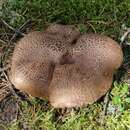en
names in breadcrumbs


Appears to be widely distributed where hardwoods (particularly oaks) grow in the northern hemisphere. The name is originally for a European collection and the name has been applied in the western US and other areas with hardwood forests.
Cap brown with brown +/- appressed scales in age, smooth when young; disc plane to depressed, scales in center with raised tips, margin often inrolled. Stalk concolorous with cap, base blue-green to greenish black to black in age both externally and internally. Spines are decurrent, short (6 mm, up to 10 mm), reddish brown to violet brown with whitish tips. Habitat is with OAKS and other HARDWOODS (& maybe pines in some areas). Odor is reported as none and the taste is intensely bitter. Pigment unknown. KOH olive to black on the flesh. Clamp connections NOT observed on the hyphae.
The above description was provided by Darvin DeShazer in a small key he created to differentiate between Sarcodon imbricatus, S. squamosus and S. scabrosus based on Johannesson, Hanna, Svengunnar Ryman, Hjordis Lundmark and Eric Danell. 1999. Sarcodon imbricatus and S. squamosus – two confused species. Mycol. Res. 103 (11): 1447-1452.
Oak and hardwood forests.
S. imbricatus and S. squamosus.
None known. Not considered edible due to bitter taste.
Hydnellum scabrosum, also called bitter tooth or bitter hedgehog, is a species of tooth fungus in the family Bankeraceae.
It was originally described by Swedish botanist Elias Fries as Hydnum scabrosum in 1836. Finnish mycologist Petter Karsten moved it to the genus Sarcodon in 1881. This species remained as Sarcodon scabrosus until 2019, when a molecular analysis using nuclear DNA showed that this and 11 other species lay genetically within the genus Hydnellum, a genus of which harder woody flesh had previously been considered a distinguishing feature from soft-fleshed Sarcodon.[1]
Within the genus it is most closely related to H. fennicum.[1]
The fruit body (mushroom) has a convex to flattened brownish cap up to 12 cm (4+3⁄4 in) across that is covered with brown scales. It can be tinged with pink at the margins and darken with age. The mushroom has yellow-brown spines under the cap that are 5 mm (1⁄4 in) long and 0.3 mm (1⁄64 in) in diameter. They are decurrent to the stem. The pinkish brown stem is 2–12 cm (3⁄4–4+3⁄4 in) high and 1–6 cm (3⁄8–2+3⁄8 in) wide, and has a narrower base that is a characteristic greyish green colour. The flesh is whitish and has a bitter taste, rendering the mushroom inedible. The flesh smells farinaceous or like watermelon when cut.[2][3]
It is found in association with hardwood forests across Eurasia to Japan, as well as North America.[4]
The species has been investigated for bioactive agents. In 2004, Tsunashi Kamo and colleagues isolated diterpenoids with experimental anti-inflammatory activity.[5] Other diterpenoids were shown to stimulate nerve growth factor (NGF).[6] Yet another agent, an alpha-pyrone, was shown to inhibit lettuce seedling growth.[4]
Sarcodon imbricatus is similar, but the scales do not become as prominent in age.[2] Other similar species include S. fennicus, S. rimosus, S. subincarnatus, and S. underwoodii.[2]
Hydnellum scabrosum, also called bitter tooth or bitter hedgehog, is a species of tooth fungus in the family Bankeraceae.